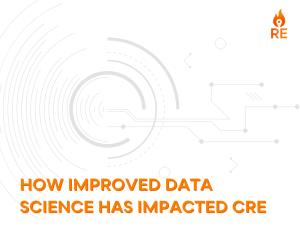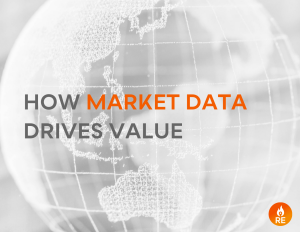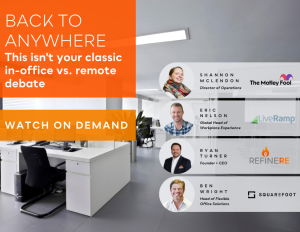Feature
How Market Data Drives Value in CRE
How Market Data Drives Value in Commercial Real Estate
CRE data has always been important, but now it’s more accessible, more expansive and more in-depth than ever before. With the right tools in place, commercial real estate data is quickly becoming the most important factor for the success of a portfolio.
Why is Reliable Commercial Real Estate Data Important?
More and more commercial real estate companies are beginning to realize the true value of the market data they collect and are adjusting the way they look at the information. They’ve always understood the value of market information, which is why CRE brokers don’t share transactional data. But CRE firms are now beginning to see the indirect value as commercial real estate data gets deeper and more actionable.
The commercial real estate data analytics platforms that exist today are already far superior to the conventional spreadsheet processes of the past, and they’re getting more intelligent by the day. In the sea of data that can now be analyzed, commercial real estate firms can make nonlinear connections that would have been difficult to see on their own and are in no way intuitive or instinctive. Using the old analysis methods, CRE firms could identify a single property for purchase using direct market data. With an advanced platform like RefineRE, brokers and corporate occupiers can use the deeper data to discover and corner an entire niche before others even know it exists.
Commercial real estate data is quickly becoming the deciding factor for portfolio decisions, which means reliability and timeliness are essential. Because CRE data is collected and aggregated in real-time, brokers and corporate occupiers are making data analysis part of the daily work tasks. Each day the data builds on itself, providing more insights and a clearer picture of what’s ahead.
The old data analysis methods are just too time-consuming to keep up. By the time you can analyze the data in a meaningful way, the opportunities you discover within the information could be gone.
As impressive as CRE data analytics already is, the next round of innovations is guaranteed to make it more actionable. Advanced visualization provides new meaning and simplifies data further so that it’s more digestible. Instead of frame-by-frame clips, advanced visualization is like a movie reel that’s constantly being fed data to show a dynamic moving picture. And artificial intelligence (AI) is expanding automation and becoming so sophisticated at directing complex decisions some experts predict bots will start replacing brokers.
If corporate occupiers thought data analysis platforms provided in-depth insights, they’ll be amazed by the latest deep learning capabilities that undercover untapped value and potential opportunities. Deep learning is bringing in unstructured data such as images, surveys and audio to fill in the information gaps that have made advanced analytics like sentiment analysis hard to gauge in the past.
Catch up on the latest from RefineRE:
How Commercial Real Estate Data Can Influence CRE Portfolio Decisions & Increase “Value” in the Process
The name of the game is to always be improving your portfolio. That means finding investments that optimize value and monitoring the market conditions that can cause holdings to go up or down in value. A steady stream of real-time data can be the key, particularly for monitoring conditions that affect making decisions. But that’s only possible if the data is usable.
Corporate occupiers and investors have had one gripe about big data from the beginning – it’s not actionable enough. Trying to make sense of various data points as the information just keeps rolling in is virtually impossible without the right system in place. For a very long time, agile decision-making didn’t include big data.
Limited data availability means limited decision making. If you’re only skimming the surface of your data you’re missing all of the bigger fish down below deeper in the data. Being able to access and analyze big data in an efficient and scalable way is a serious advantage in commercial real estate.
For example, your data could reveal grocery stores that are within three miles of an elementary school have 15% higher sales than other grocery stores in the area. You could then focus your efforts on finding a grocery retail space near a school that’s priced based on average market value but will be a bigger revenue generator than the average grocery store in town.
Using CRE data you could also be the first to spot an underlying trend before other corporate occupiers. When others question the decision to make a transaction, you can be more sure about pulling the trigger and gaining an asset that’s undervalued at the moment or isn’t near reaching its full potential.
There’s no way to do deeper analysis with the antiquated data management systems that rely much more on manual labor rather than automation. And even if your data management system is able to gather and aggregate all of the data efficiently, you can still run into the issue of having loads of data that makes little sense to someone who isn’t a trained data analyst.
Commercial Real Estate Data Predictions: What’s Next
Big data is here to stay and is only going to get bigger. Every day more data becomes available and more tools are developed to help corporate occupiers make better sense of it all. If you’re wondering what the future holds for commercial real estate data, here are a few predictions that will likely play out in the coming months.
We’ll See More Data Specialists in CRE
The commercial real estate industry is primed to change in one very significant way. You can expect to see more data specialists joining CRE firms in the near future. They’re set to become key team members that help firms fully leverage the valuable data they collect.
Predictive Analytics
Now that brokers and corporate occupiers have intuitive tools for gathering and visualizing information, the next step is tools that analyze the data to look for the trends and patterns that point to what’s on the horizon. It’s called predictive analytics. Using predictive modelling and machine learning, data analysis platforms can use historical data to make predictions about possible future outcomes.
Hyperlocal Analysis
The easier it is to analyze data, the deeper you can get with the insights. While CRE firms and corporate occupiers will continue to use information like area demographics and macroeconomics for long-term decision-making, granular data focused on highly targeted areas is becoming more of a focus. This hyperlocal analysis can be looked at from endless angles. Everything from the routes commuters take to work to the number of permits for rooftop restaurants within a 5-mile radius give you a granular, ground-level view that can completely change the performance of a portfolio.
Everyday Data Decisions
If the current trends hold true, data-based decisions are going to expand into other areas. A CRE firm may start out analyzing high-level market data solely related to property valuation and appreciation potential. However, as they become better equipped at processing data at a deeper level from even more sources, it can influence the business at other levels.
Nontraditional data variables are a huge part of predictive and hyperlocal analytics. These are variables related to CRE that previously weren’t considered commercial real estate data, such as an office building’s proximity to third-party parking lots. Analyzing property utilization, optimizing building efficiency and improving how listings are marketed to attract the best occupants are just a few examples of how CRE companies are basing more business decisions on nontraditional data variables.
A huge upside is that being able to analyze all of this traditional and nontraditional market data will make everyday decisions easier to make. When data is clearly visualized it can leave little doubt about the end result and directs the decision making so that companies can build a business case faster, come to decisions much quicker and get more profitability out of their portfolio.
Catch up on the latest from RefineRE:
Schedule a consultation with RefineRE
Here's what you can expect:
- ‣ A 15-minute call
- ‣ Identify your biggest challenges
- ‣ Explore automated solutions to optimize your strategy





